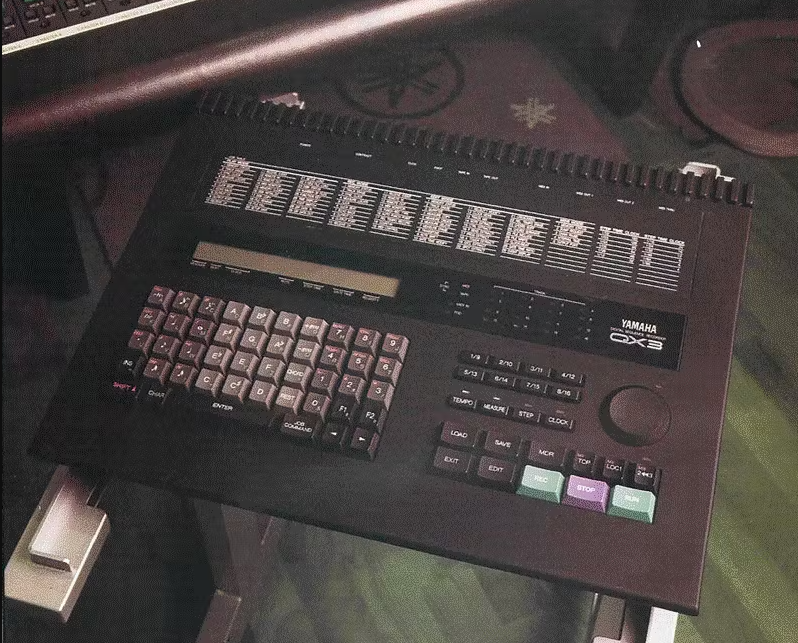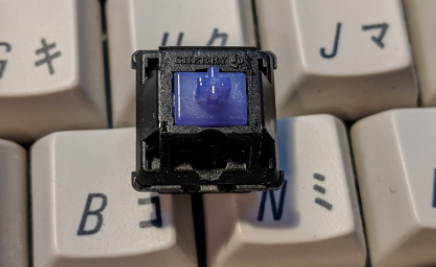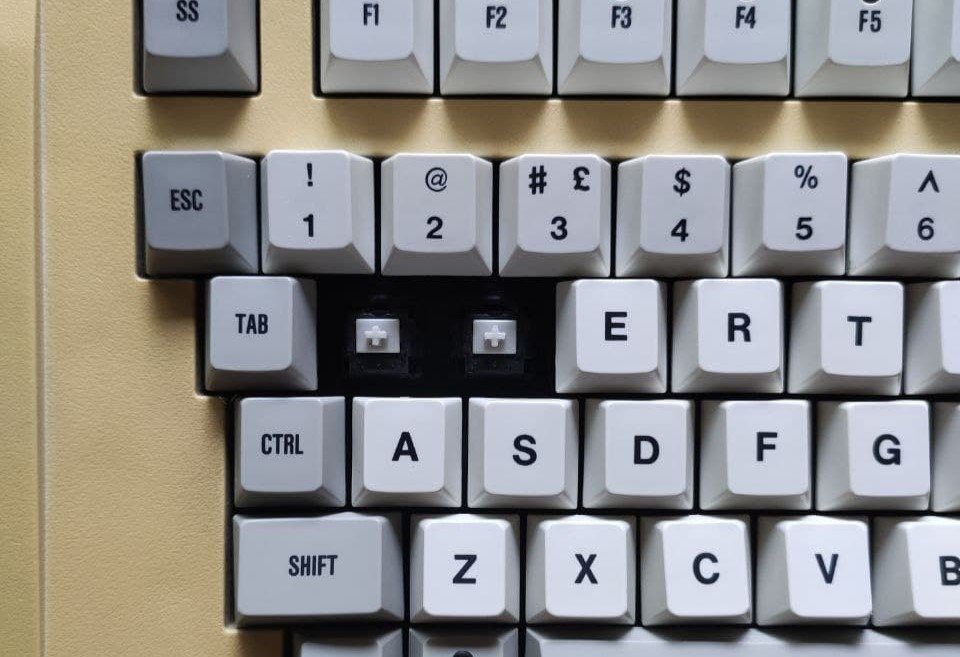The Hirose Cherry MX Rainbow
Rare mechanical keyboard switches make for some of the absolute easiest content that I can get away with. Whether its short articles, splashes at the front end of full length reviews, or simple mailday posts on social media – everybody likes to see rare, unique, or otherwise unheard of switches since there’s just so many out there to choose from nowadays. Unfortunately for me, though, the hardest part about these rare and unique switches is that they are not all that easy to come across, and even more so within the MX footprint. To me, this itch for a unique and interesting switch can usually pretty easily be scratched via modern prototypes of switches that never made it to market or color samples that were made to test out a new manufacturer’s capabilities, though I realize I’m in the minority on this one. To the vast majority of keyboard enthusiasts, the truly unique and rare stuff within the MX footprint comes in the form of vintage Cherry switches. While quite a few people will instantly jump to thinking about Nixies or MX Locks when mentioning vintage Cherry switches, I still recall the days when I first started collecting when Hirose Cherry switches were among the absolute top of the food chain when it came to rare switches. Thankfully, over the past handful of years of collecting switches, I’ve been lucky enough to encounter more Hirose switches than I could ever have hoped for all those years back when I first started. Even better yet is the array of colors that they’ve appeared in as well, a list which has grown substantially beyond what I could have ever imagined. However, I realize that while my personal knowledge of the rare variants of Hirose Cherry switches out there has grown over the years, the documentation about such definitely hasn’t changed at all. So, this short article here with more pictures than words is me finally putting to pseudo-paper all of the Cherry Hirose linear switches I’ve encountered over the years that you’ve probably not heard about!
Figure 1: Hirose Cherry logo as seen in various keyboard applications.
For those of you who don’t know anything about these legendary vintage linear switches within the MX footprint, though, let me go ahead and first introduce you to ‘Hirose’ – a Japanese manufacturing city that started many years before their entwining with the keyboard world. First founded all the way back in 1937, it wasn’t until 1968 when Hirose entered into a relationship with Cherry to become the sole Japanese distributor of microswitches produced by Cherry at the time. Very soon thereafter, this distribution network first grew into a joint venture by the name of ‘Hirose Cherry Precision’ (HCP) and then rapidly expanded into a co-production agreement, in which HCP began producing switches for Cherry in a small production facility built in Kawasaki City in 1974. While production of ‘microswitches’ for Cherry began in 1974 according to Hirose’s own history on their website, there really is no clear indication as to whether or not this referred to existing Cherry products or Hirose-branded switches. Based on the fact that nearly all vintage keyboards containing Hirose switches that I am aware of are dated from around 1983-1986, though, I’m inclined to believe that production of Hirose switches didn’t begin until after October of 1983, when Hirose states that they began the sale of “MX series” switches alongside new production at their Yamagata Factory opened in 1982. Beyond these brief historical blurbs, though, very little information has been provided by Hirose regarding the MX-style switches which they are known for within the keyboard community and to date only speculation exists as to the full tenure of their production and all of the possible variants that exist. While I can barely put together an estimate for the start date of the Cherry Hirose switches, my even less substantiated personal guess is that their production ended in the very late 1980’s at the latest, which is somewhat supported by the explosion of telephone and automobile switch OEM applications that HCP has listed as starting production in 1990. (I’m under the assumption that phones and cars are just ever so slightly larger markets than keyboards.) In spite of Hirose assuredly not producing Hirose Cherry switches anymore, they still remain active as a company to date – currently located in Yokohama, Japan with several thousand employees as of the time of writing this article.
The Hirose Rainbow
Red
Figure 2: Cherry Hirose Red switches alongside Hirose Orange and Brown switches in the Xerox Star Low Profile board which they were discovered in by twitter user @photekq.
Discovered on a Japanese Xerox Star Low Profile keyboard in 2021, Hirose Red switches are among the latest ‘new’ Hirose colors to be discovered. The keyboard, itself, features a mix of Hirose Red and Orange switches throughout the alpha and most modifier keys with Hirose Brown switches located on the spacebar and enter key as is common for that color. Currently owned by an incredibly dedicated Cherry keyboard collector, this board is a one of a kind as far as I’m aware, with one of the only other Xerox Star Low Profile keyboards being documented on Deskthority also containing rare Hirose colors discussed below. Unlike the English Xerox Star Low Profile keyboard discussed below, though, the Hirose Red switches contained in this board exclusively feature ‘CHERRY’ nameplates rather than a mix of ‘CHERRY’ and ‘HCP’.
Figure 3: Japanese Xerox Star Low Profile keyboard where the Cherry Hirose Red switches were discovered with caps on. (From twitter user @photekq.)
Figure 4: Japanese Xerox Star Low Profile keyboard where the Cherry Hirose Red switches were discovered with caps off. (From twitter user @photekq.)
Orange
Figure 5: Cherry MX Hirose Orange from personal collection.
This color is likely what immediately comes to mind when most people who are in the know think of ‘Hirose’ switches as it is the most common variant of these otherwise rare vintage switches. Available in quite a few keyboards spanning seemingly the entire production history of Hirose’s Cherry switches, the most well-known keyboard to hold Hirose Oranges is that of the ‘Yamaha QX3 Sequencer’ seen below in Figure 6. It is also not uncommon to see Hirose Clears, the second most popular variant of MX-style Hirose switches, in those boards as well. In spite of being the most common variant out there, to date only Hirose Oranges with ‘CHERRY’ nameplates have ever been seen, leading to the belief that Hirose Orange switches with ‘HCP’ nameplates simply don’t exist.
Figure 6: Advertising imagery of Yamaha QX3 Sequencer which commonly used Cherry Hirose Orange and Clear switches.
Yellow
Figure 7: Cherry and HCP Hirose Yellow switches from Deskthority user kps' Xerox Star Low Profile keyboard.
This extremely rare variant of Hirose switches was first discovered all the way back in 2012 by Deskthority user kps on a Xerox Star Low Profile keyboard from 1985. In spite of only four total Hirose Yellow switches being documented by kps and on Deskthority to date, these appear to come with both ‘CHERRY’ and ‘HCP’ nameplates – with the single ‘HCP Hirose Yellow’ being the one of the truely rarest known Cherry switch for several years due to the rarity of the Xerox Star boards being primarily used in LISP modules. This keyboard also contained HCP Hirose Clear and Cherry Hirose Pale Green switches in its original construction as can be seen in the next entry below.
Figure 8: Side profile of Cherry and HCP Hirose Yellow switches from Deskthority user kps' Xerox Star Low Profile keyboard.
Pale Green
Figure 9: Hirose Cherry Pale Green switch from Deskthority user kps' Xerox Star Low Profile keyboard which also had Hirose Yellow switches.
This extremely rare variant of Hirose switches was discovered alongside the Hirose Yellow switches on kps’ Xerox Star Low Profile board present in a modifier key position. Until very recently, this was the only known example of this switch in existence. In May of 2024, I was extremely lucky to obtain a Hirose Cherry Pale Green located in the spacebar position of an otherwise majority Hirose Cherry Clear keyboard. Unlike the original Hirose Cherry Pale Green switch, the spacebar one that I obtained also featured a ‘dotting’ mark, which is a permanent marking from the factory that is rarely found on the housings and/or stems of various vintage Cherry switches. (It is presumed to be used to mark ‘heavier’ switches for use as spacebars or numpad enter keys.) Examples of other dotted Hirose switches can be found below in Figures 17, 19, and 21.
Figure 10: Personally owned dotted Hirose Cherry Pale Green switch from recent board acquisition.
Blue/Indigo
Figure 11: Loose Cherry Hirose Indigo switch from a private collector.
Hirose Blue/Indigo switches are among the most variably colored of the rare Hirose switches and have appeared in a range from extremely faint, nearly purple-blue all the way to a deep, rich blue color depending on their source. Only noted thus far in the enter and spacebar keys of boards which contain Hirose switches, a total of only 4-5 different sightings of these switches have been had, totaling less than a dozen of them known in existence. Unlike quite a few other rare variants of Hirose switches, though, Hirose Blue/Indigo switches have been documented with both ‘CHERRY’ and ‘HCP’ nameplates, though the ’HCP’ nameplate is far less common and has only ever been seen once in a SORD keyboard to the best of my knowledge.
Figure 12: SORD M243EX keyboard with Hirose Cherry Blue/Indigo spacebar and numpad enter key. (From Daniel Beardsmore)
Figure 13: Extremely faint Hirose Cherry Blue/Indigo switch documented by keyboard collector 'Mousefan'.
Figure 14: Recently discovered HCP Hirose Indigo/Blue switch from private collector.
Violet
Figure 15: Image of "Hirose Violet" switch from Geekhack user ander.
Look, I had to include this entry so that I could complete the “rainbow” theme of this Hirose short article, okay? In spite of what you and many rare-Hirose hunting fiends have thought upon initially scrolling past this image over the years, “Hirose Violet” switches do not exist and are not a real switch as of the time of publishing this article. This photoshopped image, which dates back to 2018, was a shitpost by user ander on Geekhack referencing other fake switches being asked about in an article titled “Cherry MX Purple?” If only they’d have waited just a few more years…
Clear
Figure 16: 'CHERRY' and 'HCP' nameplate Hirose Clears from personal collection.
Hirose Clears are the second most popular color of MX-style Hirose switches behind that of Oranges and can be commonly found in Yamaha QX3 Sequences shown above in Figure 6. Unlike their common counterparts in Cherry Hirose Oranges, Hirose Clears have also been seen in quite a few vintage keyboards that contain Hirose switches, thus far largely comprising the alphas and modifier keys. To date, Hirose Clears have never been seen to be relegated to just special modifier/spacebar key positions like Hirose Brown, Blue/Indigo, and Pale Green. Also unlike Hirose Oranges, Hirose Clear switches have been noted with both ‘HCP’ and ‘CHERRY’ nameplates, making them one of only three MX-style Hirose switches to have such, including Blue/Indigo and Yellow.
Figure 17: Example of dotted Hirose Cherry Clear spacebar switch from Deskthority.
Black
Figure 18: Loose HCP Hirose Black switch from personal collection.
Hirose Black switches are among the most common of the ‘rare’ Hirose switch color variants out there, and to date have been noted in about a half dozen different keyboards of different types and from different production dates. In all of these boards that I am aware of, it’s interesting to note that the Hirose Black switches only ever seem to have ‘HCP’ nameplates, making them the only Hirose switch to not have any variants with ‘CHERRY’ nameplates. As well, it is also interesting to note that the Hirose Black switches largely comprise the bulk of the boards that they are used in, being present on modifiers and alpha keys primarily like that of Hirose Clear switches.
Figure 19: Picture of HCP Hirose Black switches with heavier, dotted enter key variant from a SORD M243EX keyboard. Photo taken by Cherry collector UncleFan and hosted on telcontar.net.
White
Figure 20: Image of opaque, Cherry Hirose White switches in SORD keyboard.
Hirose White switches are a rare variant of MX-style Hirose switches which may easily be confused with Hirose Clear switches on initial glance. However, up close comparison of these two Hirose will see the Whites as being distinctly opaque rather than translucent in color. Only ever having shown up with ‘CHERRY’ nameplates similar to that of Hirose Oranges, to date Hirose Whites have only been documented in two different SORD keyboards, both of which are held in by dedicated Cherry collectors. (In fact, one of those collectors is also the one who owns the JP Xerox Star Low Profile board with Hirose Red switches noted at the top of this article.) I also am lucky enough to own a single Hirose White in my own collection which was removed from one of those keyboards and has a permanent dot marking on its housing rather than its stem like Pale Green shown above.
Figure 21: Dotted Hirose White switch from personal collection.
Brown
Figure 22: Hirose Cherry Brown switch in its common location under a numpad enter key as documented by 'Mousefan'.
In spite of what you may guess based on the color of these rare Hirose switches, even Hirose Browns are linears as well. Present exclusively on spacebar and special modifier keys of the Hirose-containing keyboards that they have been found in, Hirose Browns are the most common ‘special’ rare Hirose color and likely have a couple dozen existing both in boards and loose in various collections around the world. Like Hirose White and Orange switches mentioned above, Hirose Brown have also only ever been seen with ‘CHERRY’ nameplates. While I am, I guess, technically lucky enough to have a Cherry Hirose Brown in my collection as it came on the numpad enter key of the keyboard that my Hirose Pale Green switch came on, the keycap mounting stem for it was cleanly broken off long before it ever went up for sale or got to me.
Figure 23: Really does bring tears to your eyes to see it...
Further Reading
Photekq’s Hirose Red Board Twitter Thread
Deskthority’s Xerox Star Low Profile Board Page
Mousfan’s Pale Hirose Indigo/Blue Switch Documentation
Geekhack Thread with “Hirose Violet”
Imgur Album of Hirose White Keyboard
Mousfan’s Dotted Hirose Clear and Hirose Brown Docs.






















